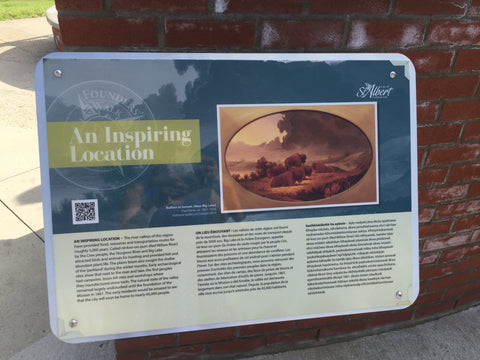
ONLINE EXHIBITION
13A. An Inspiring location
An Inspiring Location
The river valleys of this region have provided food, resources and transportation routes for roughly 5,000 years. Called nii-koo-oo-pum (Red Willow River) by the Cree people, the Sturgeon River and Big Lake attracted birds and animals for hunting and provided fish and abundant plant life. The plains bison also sought the shelter of the ‘parkland’ during the winter months. Early archaeological sites show that next to the river and lake, the first peoples had campsites, bison kill sites and workshops where they manufactured stone tools. The natural state of the valley remained largely undisturbed until the foundation of the Mission in 1861. The early residents would be amazed to see that the city will soon be home to nearly 65,000 people.
Un lieu émouvant
Les vallées de cette région ont fourni de la nourriture, des ressources et des voies de transport depuis près de 5000 ans. Big Lake et la rivière Esturgeon, appelée nii-koo-oo-pum (la rivière du saule rouge) par le peuple Cris, attiraient les oiseaux et les animaux pour la chasse et fournissaient des poissons et une abondance de conifères. Les bisons eux aussi profitaient de cet endroit pour s’abriter pendant l’hiver. Sur des sites archéologiques, nous pouvons retrouver des preuves d’activités des premiers peuples dans la région, notamment, des sites de camps, des lieux de prises de bisons et des ateliers de fabrication d’outils de pierre. Jusqu’en 1861, l’année où la Mission a été fondée, la vallée est demeurée largement dans son état naturel. Depuis, la population de la ville s’est accrue jusqu’à atteindre près de 65,000 habitants.
kasihkiskâkehk ita ayâwin
sîpiy owâyahcâwa êkota ispatinawa kîhayâw mîciwin, isihcikêwina, êkwa pimohtahowina ohci nân’taw niyânanwâw-kihcimitâtahtomitanaw askiya. kîhisiyihkâtamwak nii-koo-oo-pum (Red Willow River) ôki nêhiyawak, namêw sîpiy ekwa mistahi sâkahikan kîhayâwak piyesîsak êkwa pisiskiwak ohci mâcîwin êkwa kîhayâwak ekota kinosêwak ekwa mistahi oskihtêpak ehâyâcik. paskwâwimostosak mâka mîna kîhayâwak ‘paskohkopâwayâwin’ ispî kâpipohk. mâtayak nêstokâyâs ayâwina kâhayâki ita kâstêk sîpiy êkwa sâkahikan, nistam iyiniwak kîhayâwak kapêsiwina, ita ênipahîcik paskwâwimostoswak êkwa kiskinohamâkosiw’kamikwa ita ehosîhtâhk asinîw apacihcikana. cikêmâ êkosi ôma wâyahcâw êkîhitasktêk pâmayes mâcipayik ayamihewînînâhk êkospî 1861. êkota nistam kâwîkicik kâkoskwêyihtamwak ôtênaw iyikohk êkota kawîkiyit nân’taw nikotwâsomitanaw mîna nîyânanosâp kihcimitâtahtomitanaw ayisiyiniwak.



